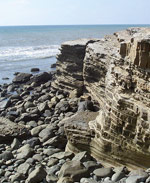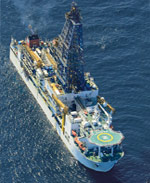- Energy from burning ice
- > In addition to abundant minerals, there are large amounts of methane hydrate beneath the sea floor. Some countries hope to become independent of energy imports by exploiting marine gas hydrate deposits near their own coasts. The technology for production, however, is not yet available. Furthermore, the risks to climate stability and hazards to marine habitats associated with extraction of the methane hydrates must first be clarified.

Valuable resource or greenhouse gas?
Methane hydrates are found in the soft seabed of continental margins all around the world, at water depths of 300 to 3000 metres. The largest deposits are encountered below 500 metres. Methane hydrates are formed from water and methane gas at certain temperatures and high pressures. The warmer the water, the higher the water pressure needs to be, and the deeper the deposits are then buried. According to current estimates, global hydrate deposits contain about 10 times more methane gas than conventional natural gas deposits. Therefore they should be taken very seriously as a potential energy resource. Test drilling has shown that it is certainly possible to harvest methane hydrates in the ocean floor. Nations such as Japan and Korea in particular, which at present are forced to import most of their energy resources, hope that methane hydrates will help them reduce their dependence on expensive foreign fuel supplies. However, methane hydrate mining in the soft sediments calls for different procedures from those used to exploit marine oil and gas, and the drilling and production technology needed is not yet available. It is expected that the appropriate equipment will be developed within the next few years; initial prototypes are already in hand. Feasibility studies are also currently being carried out. Compact production equipment for placement on the sea floor is envisaged. One major obstacle is that, unlike conventional natural gas, the methane is firmly entrapped in the hydrates and does not flow freely into the borehole. The methane hydrates must first be disso-ciated in situ, which makes the flow rate of such deposits slower than conventional gas production. It remains to be seen whether hydrate extraction at great depths is economically viable at all. As most methane hydrates form on the continental slopes, critics were at first worried that drilling into the soft sediments could possibly trigger landslides, and in turn tsunamis. In the meantime, geoscientists have conducted further research and have ruled out such concerns. Avalanche-like landslides are a natural phenomenon, they say, and quite regular occurrences. The drilling could in principle generate such slumps, but these would be too minor and their energy levels too low to cause tsunamis. There were also fears that drilling on the ocean floor could cause large amounts of methane to erupt from the seabed, rise through the water and ultimately into the atmosphere. As methane is a powerful greenhouse gas, this would exacerbate global warming. Scientists now know that this will not happen because, unlike gas and oil, the methane is bound up in hydrates and cannot flow out of the borehole on its own. It is gradually re-leased as the hydrate slowly breaks down in the soil during mining. The type of blowout that can occur in an oil borehole is therefore inherently impossible. Even if methane is released from the seabed into the water, it will be broken down by bacteria as it migrates through the water column to the surface. Today there is a broad consensus in the scientific community that global warming will not generate an intense release of methane during this century – or even during the next several centuries. However, if we consider longer geological periods of time the situation looks quite different. Climate change could warm up the oceans so much in the next few millennia that substantial volumes of hydrate – particularly in shallow marine areas – could dissociate. The released methane that is not completely broken down during its short path to the surface could end up in the atmosphere after all.


